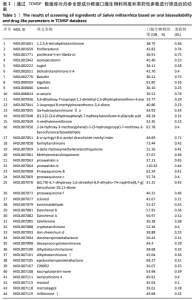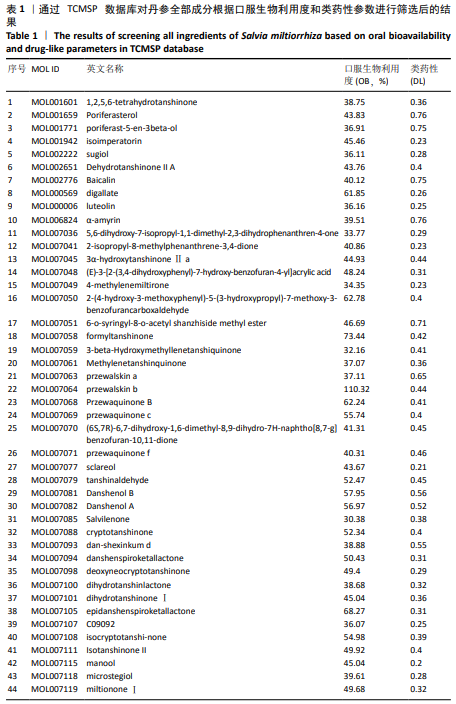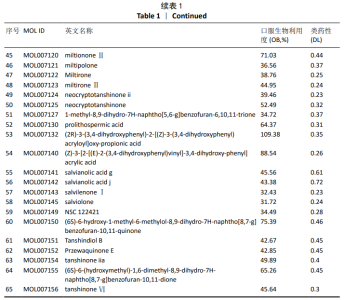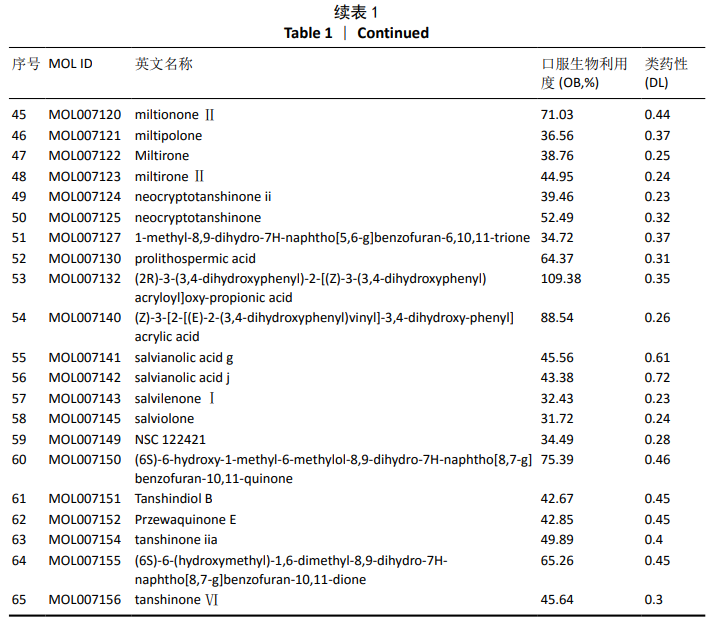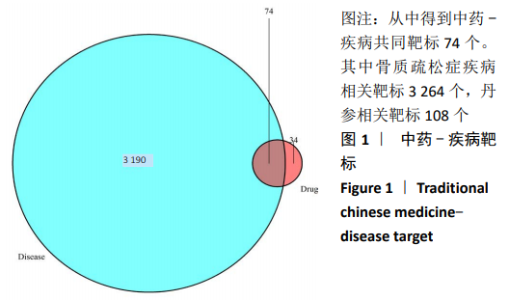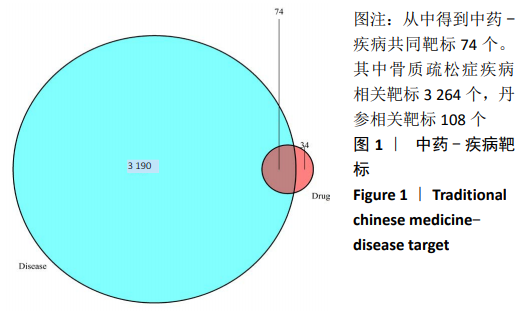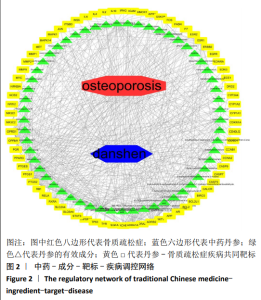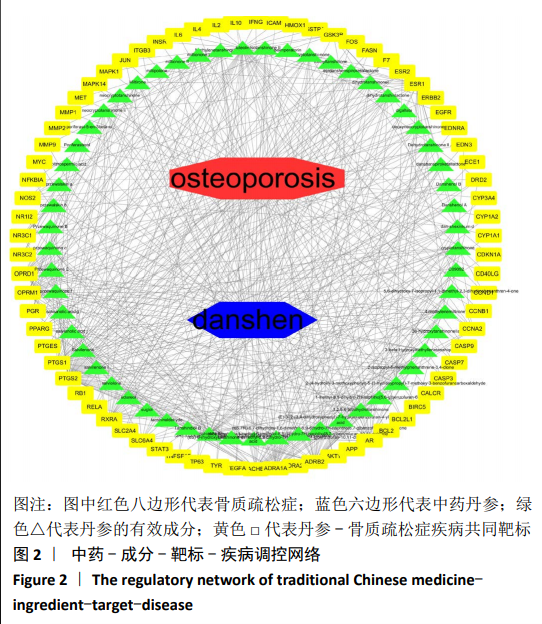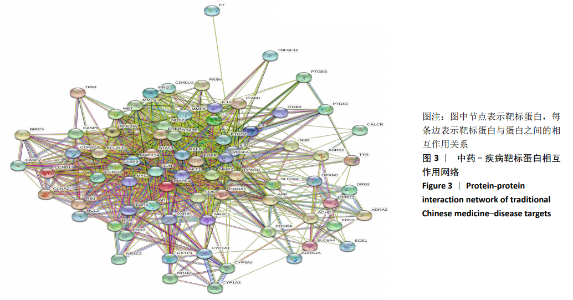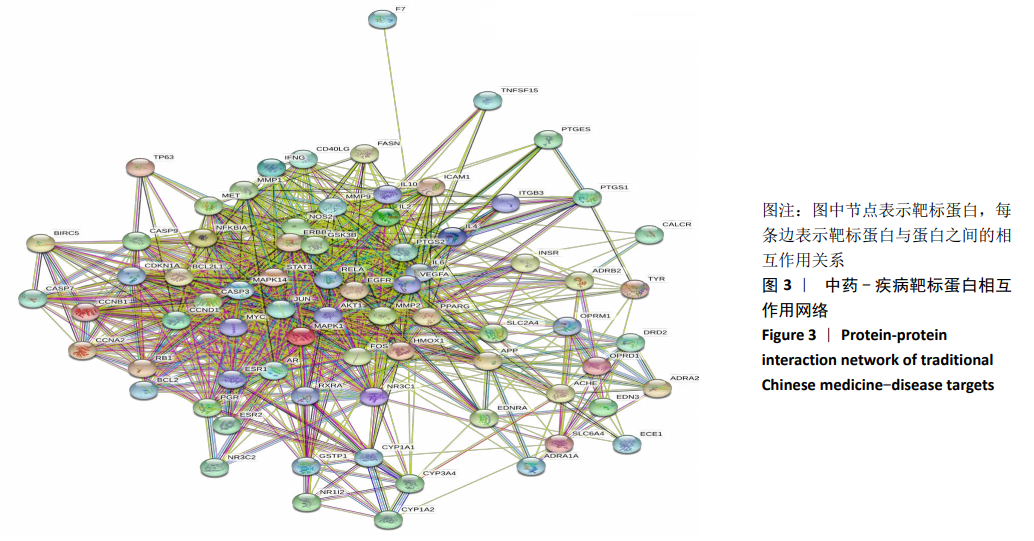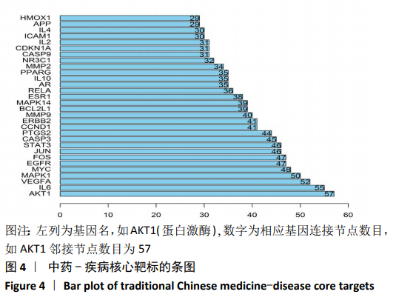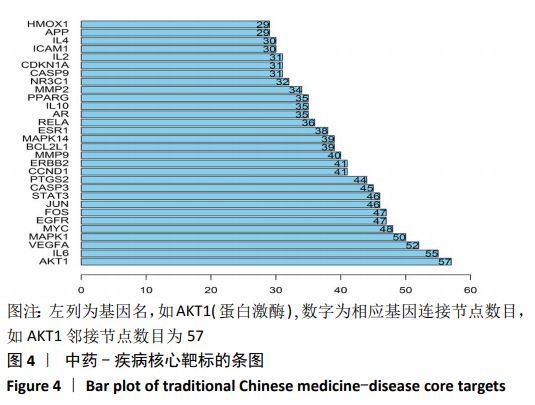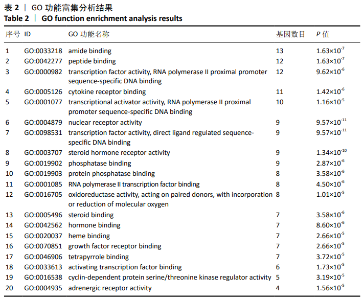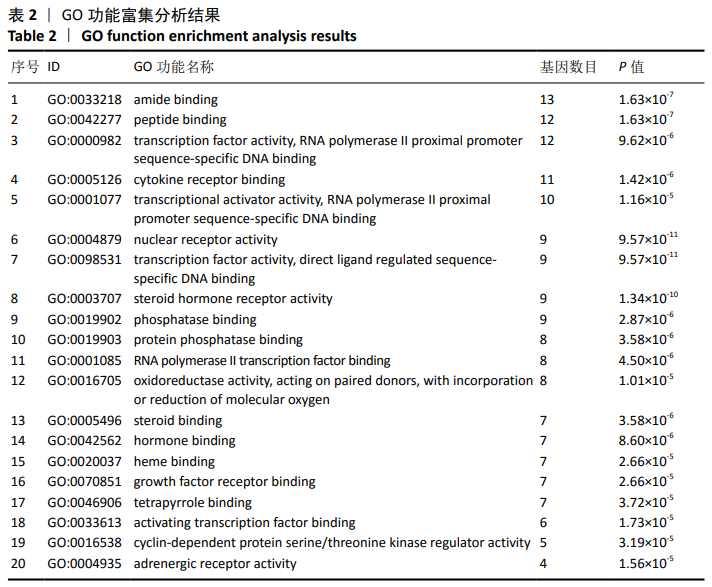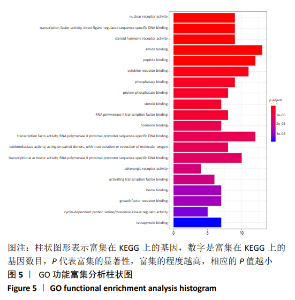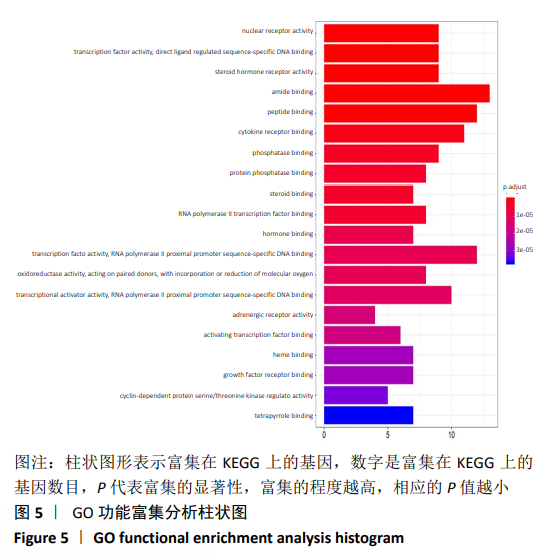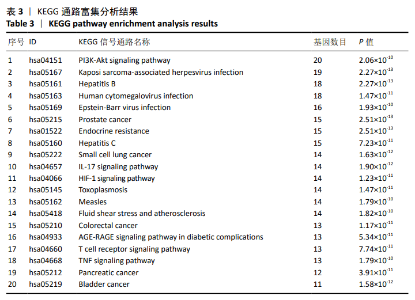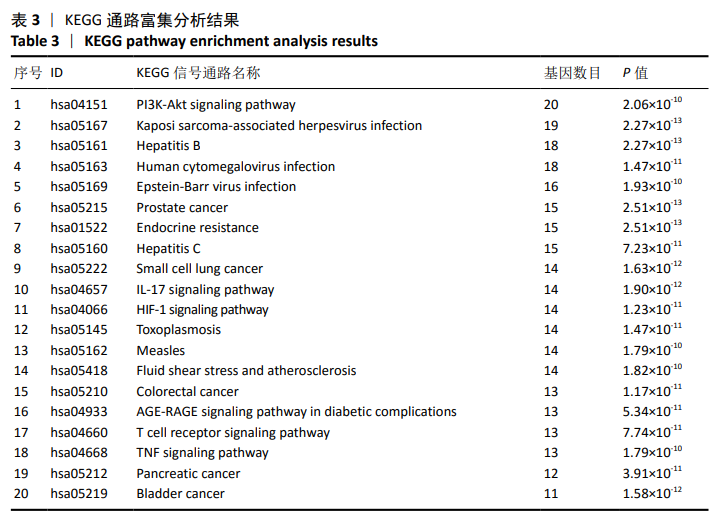Chinese Journal of Tissue Engineering Research ›› 2021, Vol. 25 ›› Issue (5): 772-778.doi: 10.3969/j.issn.2095-4344.3014
Previous Articles Next Articles
An insight into the mechanism of Salvia miltiorrhiza intervention on osteoporosis based on network pharmacology
Xiao Fangjun1, Chen Shudong2, Luan Jiyao1, Hou Yu2, He Kun1, Lin Dingkun2
- 1Second Clinical Medical School, Guangzhou University of Chinese Medicine, Guangzhou 510006, Guangdong Province, China; 2Second Affiliated Hospital of Guangzhou University of Chinese Medicine/Guangdong Provincial Hospital of Chinese Medicine, Guangzhou 510120, Guangdong Province, China
-
Received:2020-02-10Revised:2020-02-18Accepted:2020-03-18Online:2021-02-18Published:2020-12-01 -
Contact:Lin Dingkun, Doctoral supervisor, Chief physician, Second Affiliated Hospital of Guangzhou University of Chinese Medicine/Guangdong Provincial Hospital of Chinese Medicine, Guangzhou 510120, Guangdong Province, China -
About author:Xiao Fangjun, Master candidate, Physician, Second Clinical Medical School, Guangzhou University of Chinese Medicine, Guangzhou 510006, Guangdong Province, China
CLC Number:
Cite this article
Xiao Fangjun, Chen Shudong, Luan Jiyao, Hou Yu, He Kun, Lin Dingkun. An insight into the mechanism of Salvia miltiorrhiza intervention on osteoporosis based on network pharmacology[J]. Chinese Journal of Tissue Engineering Research, 2021, 25(5): 772-778.
share this article
Add to citation manager EndNote|Reference Manager|ProCite|BibTeX|RefWorks
| [1] 张智海,刘忠厚,李娜,等.中国人骨质疏松症诊断标准专家共识[J].中国骨质疏松杂志,2014, 20(9):1007-1010. [2] 胡军,张华,牟青.骨质疏松症的流行病学趋势与防治进展[J].临床荟萃,2011,26(8):729-731. [3] 单祎娜,王莉.骨质疏松症诊断和治疗进展[J].医学综述,2019,25(18):3652-3661. [4] 仇宋明,尹恒,王建伟.基于“脾肾相关”论治疗骨质疏松症的研究进展[J].中国骨质疏松杂志,2019,25(12):1809-1816. [5] 高子任,李跃华.中医血瘀证与骨质疏松症关系的研究[J].中华中医药杂志,2017,32(11): 5154-5157. [6] 郭鱼波,王丽丽, 马如风, 等.骨质疏松的中医病因病机分析及其中医药治疗的前景探讨[J].世界科学技术—中医药现代化,2015,17(4):768-772. [7] 阎博昭,李刚,许波,等.丹参治疗股骨头坏死的分子机制研究[J].安徽中医药大学学报,2018, 37(5):62-68. [8] 白璧辉,谢兴文,黄晋,等.丹参及其有效成分防治骨质疏松症研究概况[J]. 中医药临床杂志, 2018,30(5):813-816. [9] 莫朝伦,张军梅,贾莹, 等.丹参酮Ⅱ-A 对大鼠成骨细胞体外增殖分化的影响[J].贵阳医学院学报,2016,41(4):391-394. [10] 桑龙,韩红德,吴克第, 等.丹参素通过核因子κB受体活化因子配体通路 抑制破骨细胞分化治疗大鼠骨质疏松症的研究[J].中国临床药理学杂志,2019,35(23):3072-3076. [11] 陈海彬,周红光,李文婷,等. 网络药理学——中药复方作用机制研究新视角[J].中华中医药杂志,2019,34(7):2873-2876. [12] PEI T, ZHENG C, HUANG C, et al. Systematic understanding the mechanisms of vitiligo pathogenesis and its treatment by Qubaibabuqi formula.J Ethnopharmacol. 2016;190:272-287. [13] 甘东浩,薛海鹏,陈德强,等.基于网络药理学探讨骨碎补抗骨质疏松的物质基础及作用机制[J].中国实验方剂学杂志,2019,25(13):186-191. [14] MOMOTA R, OHTSUKAA. Network of anatomical texts(NAnaTex),an open-source project for visualizing the interaction between anatomical terms.Anat Science Int.2018;93(1):149-153. [15] FRANCESCHINI A, SZKLARCZYK D, FRANKILD S, et al.STRING V9.1: Protein-Protein Interaction Networks, with Increased Coverage and Integration.Nucleic Acids Res. 2013;41(Database issue):D808-815. [16] 徐森楠,庄莉,翟园园,等,基于网络药理学研究二至丸防治骨质疏松症的物质基础与作用机制[J].中国药学杂志,2018.53(22): 1913-1920. [17] JING Z, WANG C, YANG Q, et al. Luteolin attenuates glucocorticoid-induced osteoporosis by regulating ERK/Lrp-5/GSK-3β signaling pathway in vivo and in vitro.J Cell Physiol. 2019;234(4):4472-4490. [18] 郭威,李谌,李全营,等.丹参酮ⅡA对大鼠骨髓间充质干细胞成骨分化的影响[J].山东医药,2011,51(44):38-40. [19] 曾克勤,武剑,强红伟,等.从瘀论治系统性红斑狼疮继发性骨质疏松症[J]. 中医学报, 2019, 34(248):199-203. [20] 王雪鹏,李茂强,边振宇,等.PI3K/Akt信号通路在骨髓间充质干细胞增殖及成骨分化调控中的作用[J].中华骨质疏松和骨矿盐疾病杂志, 2014,7(3):250-257. [21] CHEN LL, HUANG M, TAN JY, et al. PI3K/AKT pathway involvement in the osteogenic effects of osteoclast culture supernatants on preosteoblast cells.Tissue Eng Part A.2013;19:2226-2232. [22] CZERNY B, KAMINSKI A, KURZAWSKI M, et al. The association of IL-1β, IL-2, and IL-6 gene polymorphisms with bone mineral density and osteoporosis in postmenopausal women.Eur J Obstet Gynecol Reprod Biol.2010;149(1):82-85. [23] 尚国伟.小鼠骨髓间质干细胞成骨分化及促肾上腺皮质激素的影响[D].郑州:郑州大学,2014: 1-52. [24] 张波,耿彬,谭小义,等.MAPK信号通路与骨质疏松关系的研究进展[J].中国矫形外科杂志, 2014, 22(23):2161-2164. [25] 徐会金.运动通过p38MAPK信号通路对2型糖尿病小鼠骨代谢的影响[D].上海:华东师范大学, 2016. [26] 陈亚辉,龚忠勤,崔燎.PI3K/Akt信号通路在骨质疏松病理过程中的作用[J].中国骨质疏松杂志, 2015,21(3):356-360. [27] 高润涛,范志朋.丹参注射液促进人脱落乳牙牙髓干细胞成骨/成牙分化的实验研究[J].北京口腔医学,2018,26(2):65-68. [28] ADAPALA NS,BARBE MF,TSYGANKOV AY,et al.Loss of Cbl-PI3K interaction enhances osteoclast survival due to p21-R as mediated PI3K activation independent of Cbl-b.J Cell Biochem.2014;115(7): 1277-1289. [29] NAKCHBANDI IA.Osteoporosis and fractures in liver disease: Relevance, pathogenesis and therapeutic implications.World J Gastroenterol. 2014; 20(28): 9427- 9438. [30] WIJARNPREECHA K, THONGPRAYOON C, PANJAWATANAN P, et al. Hepatitis C Virus Infection and Risk of Osteoporosis: A Meta-analysis. Gastroenterology. 2017;23:216-221. [31] 黄陈恕,汤荣睿,易小翠.慢性乙型肝炎与骨质疏松相关性初步探讨[J].中国骨质疏松杂志. 2016.22(9):1136-1139. [32] 黄英,杨颜茹.丙型肝炎后肝硬化与骨质疏松的临床研究[J].吉林医学,2012,33(23):4938-4939. [33] 刘攀,姜睿.前列腺癌骨病诊断和治疗的进展[J].临床泌尿外科杂志,2016,31(8):762-766. [34] HOFBAUER LC,RACHNER TD,COLEMAN RE,et al.endocrine asoects of bone metastases.Lancet Diabetes Endocrinol. 2014;2(6):500-502. [35] YUAN FL,LI X,LU WG,et al.Type 17 T-helper cells might be a promising therapeutic target for osteoporosis.Mol Biol Rep. 2012;39(1):771-774. [36] TYAGI AM, SRIVASTAVA K, MANSOORI MN, et al. Estrogen Deficiency Induces the Differentiation of IL-17 Secreting Th17 Cells: A New Candidate in the Pathogenesis of Osteoporosis.PLoS One. 2012; 7(9):e44552. [37] 刘海.类风湿性关节炎并发骨质疏松患者骨密度、骨代谢指标与血清 IL-17、MMP-9水平的关系[J].河北医药,2015,37(17):2576-2579. [38] 钟航,曹参,杨静,黄强.HIF-1信号通路与绝经后骨质疏松的关系研究[J].四川大学学报(医学版),2017,48(6):862-868. [39] 黄文舟,殷嫦嫦,敖鹏, 等,晚期糖基化终末产物与骨性关节炎相关性的研究进展[J].中国矫形外科杂志,2017,25(9):820-823. [40] REYNAERT NL, GOPAL P, RUTTEN EPA, et al. Advanced glycation end products and their receptor in age-related, non-communicable chronic inflammatory diseases; Overview of clinical evidence and potential contributions to diseas.Int J Biochem Cell Biol.2016;81(Pt B): 403-418. [41] Li G, Xu J, Li Z. Receptor for advanced glycation end products inhibits proliferation in osteoblast through suppression of Wnt, PI3K and ERK signaling.Biochemical and biophysical research communications 2012;423(4):684-689. |
| [1] | Yuan Jiawei, Zhang Haitao, Jie Ke, Cao Houran, Zeng Yirong. Underlying targets and mechanism of Taohong Siwu Decoction in prosthetic joint infection on network pharmacology [J]. Chinese Journal of Tissue Engineering Research, 2021, 25(9): 1428-1433. |
| [2] | Tang Hui, Yao Zhihao, Luo Daowen, Peng Shuanglin, Yang Shuanglin, Wang Lang, Xiao Jingang. High fat and high sugar diet combined with streptozotocin to establish a rat model of type 2 diabetic osteoporosis [J]. Chinese Journal of Tissue Engineering Research, 2021, 25(8): 1207-1211. |
| [3] | Geng Qiudong, Ge Haiya, Wang Heming, Li Nan. Role and mechanism of Guilu Erxianjiao in treatment of osteoarthritis based on network pharmacology [J]. Chinese Journal of Tissue Engineering Research, 2021, 25(8): 1229-1236. |
| [4] | Li Zhongfeng, Chen Minghai, Fan Yinuo, Wei Qiushi, He Wei, Chen Zhenqiu. Mechanism of Yougui Yin for steroid-induced femoral head necrosis based on network pharmacology [J]. Chinese Journal of Tissue Engineering Research, 2021, 25(8): 1256-1263. |
| [5] | Hou Guangyuan, Zhang Jixue, Zhang Zhijun, Meng Xianghui, Duan Wen, Gao Weilu. Bone cement pedicle screw fixation and fusion in the treatment of degenerative spinal disease with osteoporosis: one-year follow-up [J]. Chinese Journal of Tissue Engineering Research, 2021, 25(6): 878-883. |
| [6] | Li Shibin, Lai Yu, Zhou Yi, Liao Jianzhao, Zhang Xiaoyun, Zhang Xuan. Pathogenesis of hormonal osteonecrosis of the femoral head and the target effect of related signaling pathways [J]. Chinese Journal of Tissue Engineering Research, 2021, 25(6): 935-941. |
| [7] | Cao Xuhan, Bai Zixing, Sun Chengyi, Yang Yanjun, Sun Weidong. Mechanism of “Ruxiang-Moyao” herbal pair in the treatment of knee osteoarthritis based on network pharmacology [J]. Chinese Journal of Tissue Engineering Research, 2021, 25(5): 746-753. |
| [8] | Li Yonghua, Feng Qiang, Tan Renting, Huang Shifu, Qiu Jinlong, Yin Heng. Molecular mechanism of Eucommia ulmoides active ingredients treating synovitis of knee osteoarthritis: an analysis based on network pharmacology [J]. Chinese Journal of Tissue Engineering Research, 2021, 25(5): 765-771. |
| [9] | Liu Bo, Chen Xianghe, Yang Kang, Yu Huilin, Lu Pengcheng. Mechanism of DNA methylation in exercise intervention for osteoporosis [J]. Chinese Journal of Tissue Engineering Research, 2021, 25(5): 791-797. |
| [10] | Nie Shaobo, Li Jiantao, Sun Jien, Zhao Zhe, Zhao Yanpeng, Zhang Licheng, Tang Peifu. Mechanical stability of medial support nail in treatment of severe osteoporotic intertrochanteric fracture [J]. Chinese Journal of Tissue Engineering Research, 2021, 25(3): 329-333. |
| [11] | Zhong Yuanming, Wan Tong, Zhong Xifeng, Wu Zhuotan, He Bingkun, Wu Sixian. Meta-analysis of the efficacy and safety of percutaneous curved vertebroplasty and unilateral pedicle approach percutaneous vertebroplasty in the treatment of osteoporotic vertebral compression fracture [J]. Chinese Journal of Tissue Engineering Research, 2021, 25(3): 456-462. |
| [12] | Zhu Yun, Chen Yu, Qiu Hao, Liu Dun, Jin Guorong, Chen Shimou, Weng Zheng. Finite element analysis for treatment of osteoporotic femoral fracture with far cortical locking screw [J]. Chinese Journal of Tissue Engineering Research, 2021, 25(24): 3832-3837. |
| [13] | Chen Feng, Zhang Xiaoyun, Chen Yueping, Liao Jianzhao, Li Jiajun, Song Shilei, Lai Yu. Molecular mechanism of anhydroicaritin in the treatment of osteoarthritis: an analysis based on network pharmacology and bioinformatics [J]. Chinese Journal of Tissue Engineering Research, 2021, 25(23): 3704-3710. |
| [14] | Feng Guancheng, Fang Jianming, Lü Haoran, Zhang Dongsheng, Wei Jiadong, Yu Bingbing. How does bone cement dispersion affect the early outcome of percutaneous vertebroplasty [J]. Chinese Journal of Tissue Engineering Research, 2021, 25(22): 3450-3457. |
| [15] | Liu Chang, Li Datong, Liu Yuan, Kong Lingbo, Guo Rui, Yang Lixue, Hao Dingjun, He Baorong. Poor efficacy after vertebral augmentation surgery of acute symptomatic thoracolumbar osteoporotic compression fracture: relationship with bone cement, bone mineral density, and adjacent fractures [J]. Chinese Journal of Tissue Engineering Research, 2021, 25(22): 3510-3516. |
| Viewed | ||||||
|
Full text |
|
|||||
|
Abstract |
|
|||||
